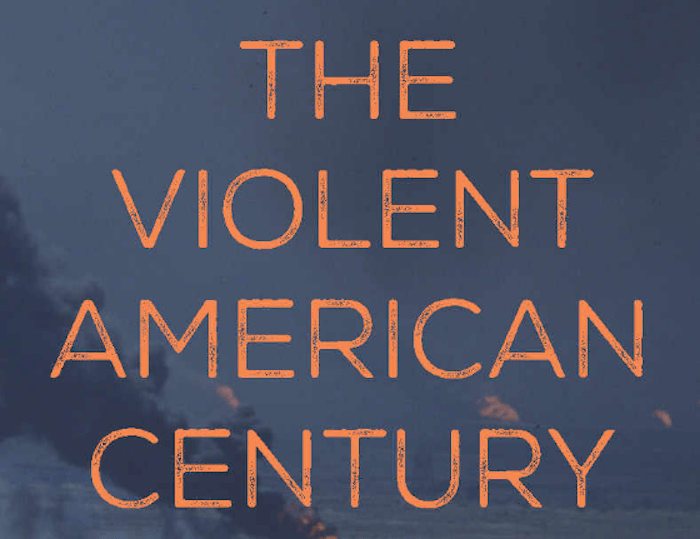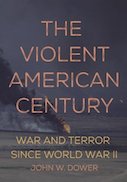The Violent American Century
“The Violent American Century: War and Terror Since World War II”
A book by John Dower
“The Violent American Century”
Purchase in the Truthdig Bazaar
Purchase in the Truthdig Bazaar
In 1941, Henry Luce, the mogul of influential and popular magazines from Time and Life to Fortune and Sports Illustrated, declared the 20th century to be the American Century. By the gauge of prosperity, power and influence, the United States did emerge from World War II as the defining leader of the “free world” and, with the dissolution of the Soviet Union in 1991, of the entire world.
Historian John Dower borrows Luce’s “American Century” as a heuristic device in tracing the lengthening arc of U.S. dominance in weapon development, militarism and military empire—without peer in history—since World War II. Thus, his title: “The Violent American Century: War and Terror Since World War II.”
Click here to read chapter one from “The Violent American Century” at Truthdig.
With exceptional concision, Dower delineates the ongoing structural impacts of World War II to frame more thoroughly and intricately than do U.S. textbooks and war hagiography the war’s influence on most subsequent conflicts and world politics. Dower writes that the “good war,” as it has been christened and cleansed, was “the apogee of industrialized total war.” Civilians were targets of strategic bombing in cities by the U.S. and Britain; new weapons of mass destruction were developed and used (atomic bombs); and countries were left “explosively divided” (Korea, Vietnam, Germany and China).
Among the war’s legacies were global financial and political institutions, the most idealistic being the United Nations, with its Universal Declaration of Human Rights; “pathbreaking war crimes trials” (though the victors never tried themselves for war crimes); and the eventual end of European colonialism. On the bleaker side, World War II concluded with a hostilely divided world and a burgeoning military/congressional/industrial complex that has governed U.S. response to conflict ever since.
The Cold War with its nuclear terror and proxy wars in Korea and Southeast Asia; the U.S. transition to superpower status in the 1990s; and post-9/11 wars—all are examined with a lens that captures the “essentially bipolar” nature of American macro behavior in the world. Dower describes it as “hubristic and overwhelmingly powerful by material measures, yet fearful and insecure.” Think compulsive national anxiety over an alleged missile gap with the Soviets in the ’50s and early ’60s; the domino theory of the ’60s and ’70s positing that one country’s becoming communist would cause surrounding countries to do so also; the obsession with getting over failure in Vietnam in the ’70s and ’80s; and the manic fear of terrorism today. Fear of menacing, “existential enemies primed the political pump to maintain support for a massive military machine” and the expansion of a national security state.
A balance of terror, via nuclear weapons buildup, marked 40 years of U.S.-Soviet bombast and confrontation. U.S. military planners chillingly projected nuclear bomb attacks on the Soviet Union and China that would kill hundreds of millions of Russians and Chinese. Only recently have once-prominent insiders, including Gen. George Lee Butler, commander of the Strategic Air Command in the early 1990s, and William Perry, former secretary of defense in the Clinton administration, passionately critiqued this psychopathology of deterrence.
A provocative current runs through this book, one that challenges current dogma on the decline in global violence and incline toward global peace since 1945. This proposition of a more peaceful world is based in good part on fewer conflict-related deaths since World War II and the trend in precision weapons. Dower counters this conclusion with a multitude of examples: the growing conflict-based refugee crisis that approaches that of World War II; “the political harm to democracy” from the colossal post-9/11 national security state devoted to sustaining “a state of semi-war”; and the costs of war that magnify our debt for decades to come, among others.
Moreover, who is left in Trump’s administration to make a case for negotiation over military intervention? Given the larding of government with generals, private security lobbyists, defense industry personnel and Wall Street war profiteers, there is no one vested in the cause of peace.
Dower opens and closes his book with the acknowledgement that America’s “prosperity and professed ideals are still beacons to many,” reinforcing the mystique of exceptionalism despite the government’s “intoxication with brute force. …”
How does the top global military superpower and largest trader in weapons of war remain a beacon of democratic ideals? A Nigerian friend living in Europe recently provided a partial response: She noted that pervasive counter demonstrations and persistent citizen protest against the Trump administration’s policies—protests against banning Muslims and on behalf of women’s rights, black lives and climate science—reflect our country’s ideals of freedom of expression, equality, and tolerance to the world.
Side-by-side with widespread democratic resistance to domestic policies, there is, however, a national quietism about the seemingly unstoppable full spectrum, international dominance envisioned by both political parties since World War II, as distilled in “The Violent American Century.” Administrations from both parties, for example, engaged directly and indirectly in the overthrow of at least two dozen Latin American governments between 1948 and 1990. CIA manuals on torture and the army’s School of the Americas (dubbed School of Assassins) have trained right-wing Latin American military officers and police in tactics to conduct the “dirty wars” that ravaged so many South American countries.
Hundreds of billions spent since 9/11 on foreign military training in more than 150 countries and combating terrorism globally has resulted in doubling the likelihood of military-backed coups by those trained, with no evidence of promoting democracy. Yet too few—in the media and the American public—are versed in or troubled by this underbelly of U.S. exceptionalism. Dower has written a much-needed correction to mainstream American history texts and a bracing challenge to the trope of American exceptionalism. Its case for American military muscularity at the expense of democracy and world peace is unassailable.





Geen opmerkingen:
Een reactie posten